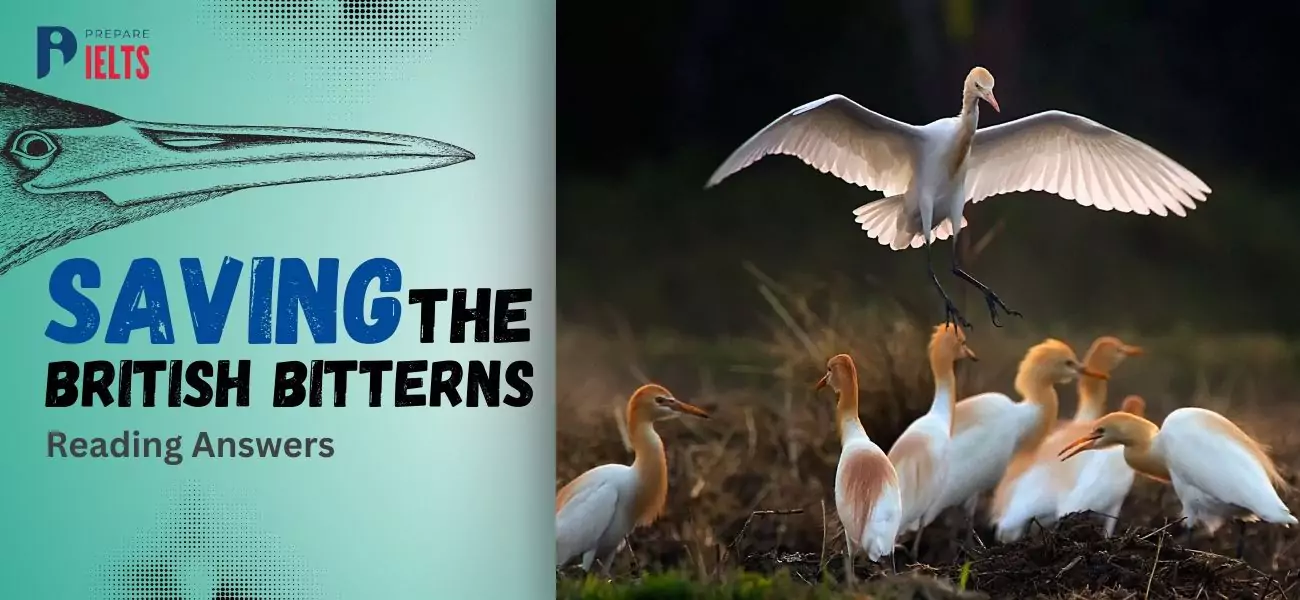
Overview
IELTS test takers must improve their reading comprehension to ace their language ability and perform well on the reading component of the exam. "Saving the British Bitterns" is one of the many topics that can be asked; it's an intriguing subject that captivates and educates.
This blog will assist you in analysing the major concepts and significance of the topic in the IELTS reading part. It will give applicants answers and explanations to help them better comprehend and perform. Now, let us get started with the blog!
Saving The British Bitterns Reading Passage
Below is the passage on the topic, Saving The British Bitterns. Make sure that you complete this section in 20 minutes. After reading this passage, you can attempt the questions.
A. Breeding bitterns became extinct in the UK by 1886, but following re-colonisation early last century, numbers rose to a peak of about 70 booming (singing) males in the 1950s, falling to fewer than 20 by the 1990s. In the late 1980s, it was clear that the bittern was in trouble, but there was little information on which to base recovery actions.
B. Bitterns have cryptic plumage and shy nature, usually remaining hidden within the cover of reedbed vegetation. Our first challenge was to develop standard methods to monitor their numbers. The boom of the male bittern is its most distinctive feature during the breeding season, and we developed a method to count them using the sound patterns unique to each individual. This not only allows the US to be much more certain of the number of booming males in the UK but also enables us to estimate the local survival of males from one year to the next.
C. Our first direct understanding of the habitat needs of breeding bitterns came from comparisons of reedbed sites hat had lost their booming birds with those that retained them. This research showed that bitterns had been retained in reedbeds where the natural process of succession, or drying out, had been slowed through management. Based on this work, broad recommendations on how to manage and rehabilitate reedbeds for bitterns were made, and funding was provided through the EU LIFE Fund to manage 13 sites within the core breeding range. This project, though led by the RSPB, involved many other organisations.
D. To refine these recommendations and provide fine-scale, quantitative habitat prescriptions on the bitterns’ preferred feeding habitat, we radio-tracked male bitterns on the RSPB’s Minsmere and Leighton Moss reserves. This showed clear preferences for feeding in the wetter reedbed margins, particularly within the reedbed next to larger open pools. The average home range sizes of the male bitterns we followed (about 20 hectares) provided a good indication of the area of reedbed needed when managing or creating habitat for this species.
Female bitterns undertake all the incubation and care of the young, so it was important to understand their needs as well. During our research, we located 87 bittern nests and found that female bitterns preferred to nest in areas of continuous vegetation well into the reedbed but where water was still present during the driest part of the breeding season.
E. The success of the habitat prescriptions developed from this research has been spectacular. For instance, at Minsmere, booming bittern numbers gradually increased from one to 10 following reedbed lowering, a management technique designed to halt the drying out process. After a low point of 11 booming males in 1997, bittern numbers in Britain responded to all the habitat management work and started to increase for the first time since the 1950s.
F. The final phase of research involved understanding the diet, survival and dispersal of bittern chicks. To do this we fitted small radio tags to young bittern chicks in the nest to determine their fate through to fledging and beyond. Many chicks did not survive to fledge and starvation was found to be the most likely reason for their demise. The fish prey fed to chicks was dominated by those species penetrating into the reed edge. So, an important element of recent studies (including a PhD with the University of Hull) has been the development of recommendations on habitat and water conditions to promote healthy native fish populations.
G. Once independent, radio-tagged young bitterns were found to seek out new sites during their first winter; a proportion of these would remain on new sites to breed if the conditions were suitable. A second EU LIFE funded project aims to provide these suitable sites in new areas. A network of 19 sites developed through this partnership project will secure a more sustainable UK bittern population with successful breeding outside of the core area, less vulnerable to chance events and sea level rise.
H. By 2004, the number of booming male bitterns in the UK had increased to 55, with almost all of the increase being on those sites undertaking management based on advice derived from our research. Although science has been at the core of the bittern story, success has only been achieved through the trust, hard work and dedication of all the managers, owners and wardens of sites that have implemented, in some cases very drastic, management to secure the future of this wetland species in the UK.
The constructed bunds and five major sluices now control the water level over 82 ha, with a further 50 ha coming under control in the winter of 2005/06. Reed establishment has principally used natural regeneration or planted seedlings to provide small core areas that will in time expand to create a bigger reed area. To date nearly 275,000 seedlings have been planted and reed cover is extensive. Over 3 km of new ditches have been formed, 3.7 km of existing ditch have been re-profiled and 2.2 km of old meander (former estuarine features) have been cleaned out.
I. Bitterns now regularly winter on the site with some indication that they are staying longer into the spring. No breeding has yet occurred but a booming male was present in the spring of 2004. A range of wildfowl breeds, as well as a good number of reedbed passerines including reed bunting, reed, sedge and grasshopper warblers. Numbers of wintering shovelers have increased so that the site now holds a UK important wintering population. Malltraeth Reserve now forms part of the UK network of key sites for water vole (a UK priority species) and 12 monitoring transects have been established. Otter and brown-hare occur on the site as does the rare plant, pillwort.
Saving The British Bitterns - Questions and Answers
Questions 1 - 7
The reading passage has nine paragraphs, A - I
List of Headings
A - research findings into habitats and decisions made
B - fluctuation in bittern number
C - protect the young bittern
D - international cooperation works
E - began in calculation of the number
F - importance of food
G - research has been successful
H - research into the reedbed
I - reserve established holding bittern in winter
Choose the correct heading for paragraphs A-I from the list.
Write the correct number, i-viii, in boxes 14-20 on your answer sheet.
1. Paragraph A
2. Paragraph B
3. Paragraph C
4. Paragraph D
5. Paragraph F
6. Paragraph G
7. Paragraph H
Answer 1: ii
Explanation 1: The 1st line of the 1st paragraph describes how bitterns are almost extinct in the UK but are coming back later. Throughout the century, this cycle will recur. Therefore, "fluctuation in bittern number" is the correct response.
Answer 2: v
Explanation 2: According to the second line of the second paragraph, the conventional techniques for tracking the quantity of male bitterns are discussed in the second paragraph. They came up with a way to tally them based on the distinctive sound patterns that belong to each person. "Began in the calculation of the number" is the right response in this case.
Answer 3: i
Explanation 3: In the third line of the third paragraph, the study's findings indicate that bitterns have been preserved in reedbeds. The bitterns had slowed down naturally due to succession or drying out. However, suggestions were made for maintaining and restoring reedbeds. Financing came from the EU LIFE Fund. Therefore, the correct answer is that the solution is ‘research findings into habitats and decisions made.’
Answer 4: viii
Explanation 4: The second line of the fourth paragraph discloses the additional research on bitterns on the RSPB's Minsmere and Leighton Moss reserves. During their investigation, they discovered 87 bittern nests and discovered that female bitterns favoured nesting deep into the reedbed in locations with continuous vegetation. For paragraph D, "research into the reedbed" would be a suitable heading.
Answer 5: vi
Explanation 5: The first line of the 6th paragraph, The additional research on bitterns on the Minsmere and Leighton Moss reserves of the RSPB is disclosed in the fourth paragraph. During their investigation, they discovered 87 bittern nests and discovered that female bitterns favoured nesting deep into the reedbed in locations with continuous vegetation. Therefore, for paragraph D, "research into the reedbed" would be a suitable heading.
Answer 6: iii
Explanation 6: The second initiative, sponsored by EU Life, tries to safeguard juvenile bitterns; this is the subject of the 7th paragraph. This collaboration effort secured a more sustainable UK bittern population with successful breeding outside the core area by developing a network of 19 sites. So, "Protect the young bittern" would be a fitting heading to represent the same.
Answer 7: iv
Explanation 7: The 3rd line of the 8th paragraph demonstrates the triumph of all the managers, owners, and wardens of the sites that have been implemented, as well as their hard work, trust, and dedication. As a result, there are now 55 booming male bitterns. The header "International Cooperation Works" would be acceptable for this paragraph in light of the abovementioned facts.
Questions 8 - 13
Answer the questions below.
Choose NO MORE THAN THREE WORDS AND/OR A NUMBER from the passage for each answer.
8. When did the bird of bittern reach its peak of number?
9. What does the author describe the bittern’s character?
10. What is the main cause for the chick bittern’s death?
11. What is the main food for chick bittern?
12. What system does it secure for the stability of the bittern’s population?
13. Besides bittern and rare vegetation, what mammal does the protection plan benefit?
Answer 8: 1950s
Explanation 8: According to the 2nd line of the 1st paragraph, it is evident that in the 1950s, the number of booming (singing) male bitterns peaked at roughly 70.
Answer 9: being shy/ shyness
Explanation 9: In the first line of the second paragraph, the characteristics of Bitterns are discussed. With their mysterious feathers and shy disposition, bitterns typically stay concealed among the reedy undergrowth.
Answer 10: starvation
Explanation 10: In the 4th line of the 6th paragraph, the author discusses the cause of the bitterns’ death. Many chicks did not survive to fledge, and starvation was found to be the most likely reason for their demise.
Answer 11: (native) fish
Explanation 11: In the 4th line of teh 6th paragraph, the author discusses bitterns' primary dietary source. Species that penetrated the reed edge accounted for the majority of the fish prey for the chicks. Consequently, habitat and water quality guidelines have been developed to support the growth of native fish populations.
Answer 12: partnership project/ network (of sites)/ partnership project network
Explanation 12: In the 3rd line of the 7th paragraph, it is mentioned that the second EU Life-sponsored initiative which attempts to create suitable sites in new areas. By successfully breeding outside the core area, this collaborative effort will provide a more sustainable population of bitterns in the UK that is less susceptible to random events and sea level rise.
Answer 13: Otter and brownware
Explanation 13: In the 6th line of the 9th paragraph, the author discusses how the EU programs have benefitted other living things. Twelve monitoring transects have been created, and Malltraeth Reserve is now a member of the UK network of critical sites for water vole, a UK priority species. Rare plants like pillwort can be found there, along with otters and brown hares.
Question 14
Choose the correct letter: A, B, C or D.
Write your answers in box 27 on your answer sheet.
14. What is the main purpose of this passage?
A - Main characteristic of a bird called bittern.
B - Cooperation can protect an endangered species.
C - The difficulty of accessing information about a bittern’s habitat and diet.
D - To save wetland and reedbed in the UK.
Answer 14: B
Explanation 14: The 9th paragraph provides a quick summary of the entire passage. This passage's primary goal is to discuss working together to safeguard endangered species.
Register Now, for a free Mock test - Join Today!
Conclusion
In summary, Reading comprehension is one of the most crucial skills on the long and difficult road to IELTS achievement. By exploring various topics, including "Saving The British Bitterns" and numerous others, applicants may build a solid foundation for addressing the reading component. IELTS applicants can use this blog's strategies and recommendations as a guide to help them achieve their desired scores. As perseverance is the secret to unrivalled success in the field of language learning, let this serve as motivation to keep practising.
We hope you now know how to respond to the IELTS reading passage questions. But, if you are still looking for more details or would like to prepare for IELTS, you can contact Prepare IELTS Exam (PI) expert counsellors for further guidance. Our team of education experts is dedicated to providing you with the best test material and guidance to ace the IELTS exam. You can get a one-on-one counselling session and an IELTS online practice test via our platform. Contact us at info@prepareieltsexam.com or call us at +91 9773398388 for further queries.
Latest Blogs
-

IELTS Score for Canada: Minimum IELTS Requirement for Canada 2025
2024-09-27 18:24:14
-

IELTS Apology Letter for General Training: IELTS Writing Task 1
2024-09-25 16:38:03
-

Minimum IELTS Score for Australia: Student Visas, Universities, and PR in Australia
2024-09-23 18:09:51
-

Common IELTS Speaking Topics with Answers
2024-09-20 18:21:56
-

Describe a foreign culture that you like: IELTS speaking cue card
2024-09-18 16:14:11
-

Describe a Rainy Day IELTS Speaking cue card
2024-09-18 11:11:32
-

Describe a new law you would like to introduce in your country IELTS cue card
2024-09-13 17:17:46
-

Describe your favourite weather: IELTS cue card
2024-09-11 18:01:28
-

Describe an enjoyable journey by public transport: IELTS cue card
2024-09-09 18:05:45
-

Step-by-Step Guide to IELTS Registration in India for the Year 2024 & 2025
2024-09-07 12:59:51


